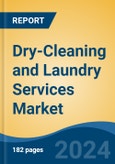Online is the fastest growing segment, Asia-Pacific is the largest market globally
Speak directly to the analyst to clarify any post sales queries you may have.
10% Free customizationThis report comes with 10% free customization, enabling you to add data that meets your specific business needs.
Key Market Drivers
Busy lifestyles and the increasing demand for convenience are critical drivers for the global dry-cleaning and laundry services market. Modern professional and personal demands constrain the time available for household chores, leading to a strong consumer inclination to outsource tasks such as laundry. This societal shift positions professional garment care as an essential convenience, with consumers seeking efficient, time-saving solutions to manage their schedules. According to the Bureau of Economic Analysis, in July 2025, personal consumption expenditures on services increased by 0.1% in June, indicating a continued inclination towards outsourced solutions.Key Market Challenges
Escalating operational costs, particularly those related to energy consumption, water usage, and labor, significantly impede the growth of the global dry-cleaning and laundry services market. These increasing expenditures directly compress profit margins for service providers, making it difficult to maintain competitive pricing while simultaneously investing in necessary upgrades and expansion. Higher operational overheads limit the capital available for modernizing equipment, adopting environmentally compliant technologies, or enhancing service delivery infrastructure.Key Market Trends
The dry-cleaning and laundry services market is adopting sustainable cleaning practices, driven by consumer demand and environmental regulations. This trend involves transitioning to non-toxic solvents, implementing water and energy-efficient machinery, and embracing circular economy principles. According to the European Textile Services Association (ETSA) in May 2024, their manifesto highlighted the industry's commitment to reducing energy, chemical, and water use in textile services. This focus extends to waste reduction strategies. Klopman International received the 2024 Climate Impact Award from ETSA for its We-ar Circular Post-Consumer Recycled Fabrics concept, demonstrating a tangible commitment to sustainable material use.Key Market Players Profiled:
- Alliance Laundry Systems LLC
- The Huntington Company
- ZIPS Cleaners
- Alsco Pty Limited
- Rinse, Inc.
- Marberry Cleaners & Launderers, Inc.
- The Procter & Gamble Company (Tide Dry Cleaners)
- Siderblue Limited (BONI)
- East Rand Cleaners
- AL Rafidain Laundry
Report Scope:
In this report, the Global Dry-Cleaning and Laundry Services Market has been segmented into the following categories:By Service Type:
- Dry Cleaning
- Duvet Cleaning
- Laundry
- Others
By End User:
- Commercial
- Residential
By Business Type:
- Online
- Offline
By Region:
- North America
- Europe
- Asia Pacific
- South America
- Middle East & Africa
Competitive Landscape
Company Profiles: Detailed analysis of the major companies present in the Global Dry-Cleaning and Laundry Services Market.Available Customizations:
With the given market data, the publisher offers customizations according to a company's specific needs. The following customization options are available for the report:- Detailed analysis and profiling of additional market players (up to five).
This product will be delivered within 1-3 business days.
Table of Contents
Companies Mentioned
- Alliance Laundry Systems LLC
- The Huntington Company
- ZIPS Cleaners
- Alsco Pty Limited
- Rinse, Inc.
- Marberry Cleaners & Launderers, Inc.
- The Procter & Gamble Company (Tide Dry Cleaners)
- Siderblue Limited (BONI)
- East Rand Cleaners
- AL Rafidain Laundry
Table Information
| Report Attribute | Details |
|---|---|
| No. of Pages | 182 |
| Published | November 2025 |
| Forecast Period | 2024 - 2030 |
| Estimated Market Value ( USD | $ 73.45 Billion |
| Forecasted Market Value ( USD | $ 111.34 Billion |
| Compound Annual Growth Rate | 7.1% |
| Regions Covered | Global |
| No. of Companies Mentioned | 10 |









